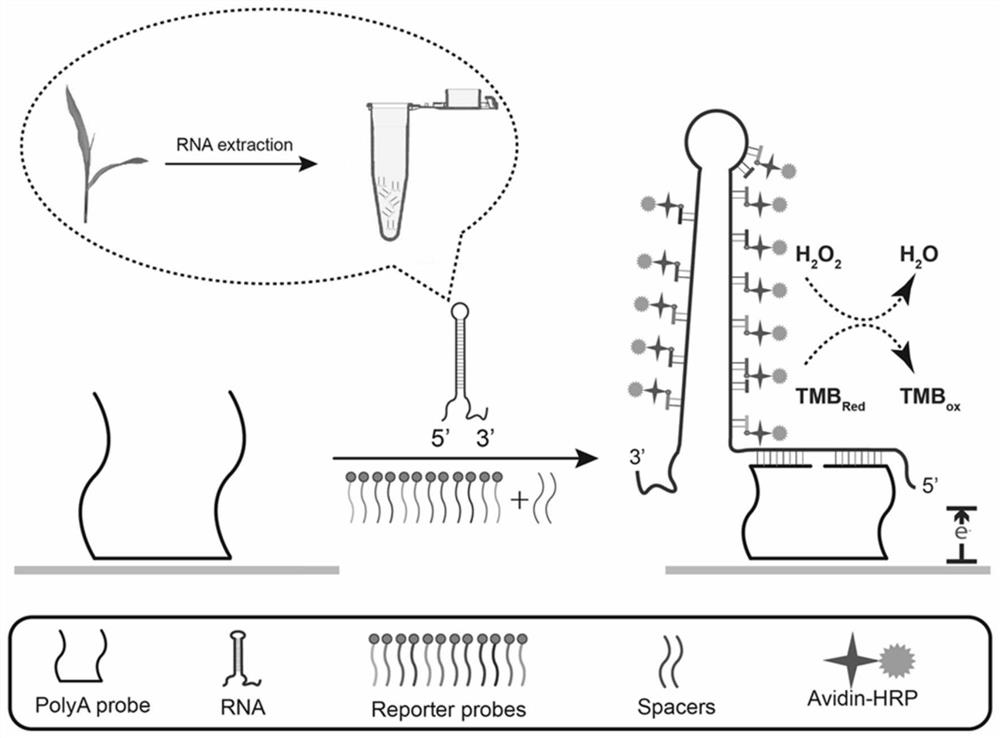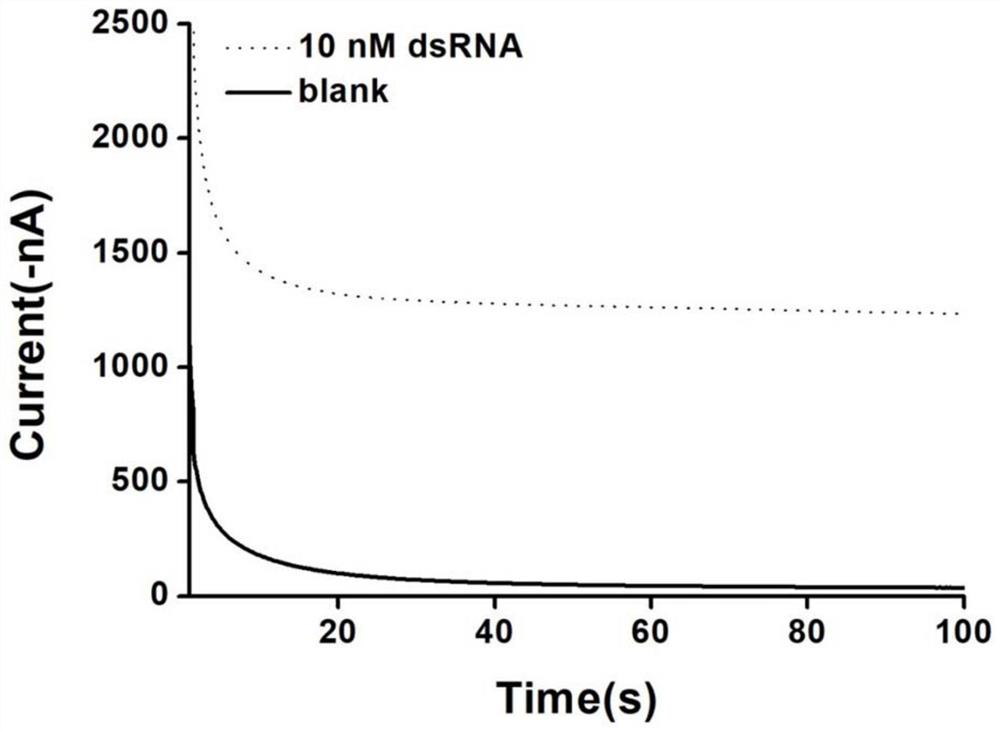Electrochemical sensor based on triblock probe and application of electrochemical sensor in detection of transgenic double-stranded RNA
An electrochemical, triblock technology, applied in the direction of electrochemical variables of materials, scientific instruments, biochemical equipment and methods, etc., can solve the problems of weak specificity of RT-PCR, improve the capture ability, improve the detection sensitivity, improve the The effect of the signal-to-noise ratio
- Summary
- Abstract
- Description
- Claims
- Application Information
AI Technical Summary
Problems solved by technology
Method used
Image
Examples
Embodiment 1
[0056] The preparation of embodiment 1 transgenic double-stranded RNA
[0057] This embodiment prepares transgenic double-stranded RNA as the detection target of the electrochemical sensor, including the following steps:
[0058] (1) Synthesizing a DNA fragment with a length of 852bp comprising 261bp inverted repeat sequence and 98bp spacer sequence, and cloning it into the pET-28a(+) vector with T7 promoter;
[0059] (2) PCR is used to amplify a DNA fragment of 1034bp in length containing the target RNA and the T7 promoter from the recombinant plasmid;
[0060] (3) After purification, use the 1034bp DNA fragment as a template, under the action of RNA polymerase, transcribe in vitro at 37°C for 1 hour, and synthesize the target RNA;
[0061] (4) The synthesized target RNA is purified and stored at -80°C until use.
Embodiment 2
[0062] The preparation of embodiment 2 electrochemical sensors
[0063] After the gold electrode was polished by alumina, it was placed in ethanol and water for ultrasonication for 2 minutes; then connected to the circuit of the electrochemical workstation, and electrochemically cleaned with 0.5M sulfuric acid aqueous solution;
[0064] After electrochemical cleaning, the gold electrode was washed with water and dried with nitrogen gas, and 3 μM triblock probe-1, triblock probe-2 or triblock probe-3 were added dropwise, and incubated overnight at 45°C;
[0065] The electrode was sealed with 0.1 mM mercaptoethanol (MCH) at room temperature for 1 h to prepare an electrochemical sensor modified with a triblock probe and stored at 4°C until use.
Embodiment 3
[0066] Embodiment 3 electrochemical detection
[0067] The principle of electrochemical detection is as figure 1 As shown, the triblock probe modified on the surface of the gold electrode is used as the capture probe to perform specific complementary hybridization with the target transgenic double-stranded RNA. After the biotin-labeled detection probe and spacer probe are combined with the target transgenic double-stranded RNA, the With the strong affinity of "biotin-avidin", HPR is labeled on the sandwich structure of triblock probe-target transgenic double-stranded RNA-detection probe, and TMB or H 2 o 2 , through the generated electrochemical signal to realize the detection of transgenic double-stranded RNA.
[0068] Proceed as follows:
[0069] (1) 10nM target transgenic double-stranded RNA prepared in Example 1, 100nM biotin-labeled detection probe (SEQ ID NO:4~20) and spacer probe (SEQ ID NO:21~22) were mixed in hybridization buffer (50mM Na 2 HPO 4 , 50mMNaH 2 PO...
PUM
 Login to View More
Login to View More Abstract
Description
Claims
Application Information
 Login to View More
Login to View More - R&D
- Intellectual Property
- Life Sciences
- Materials
- Tech Scout
- Unparalleled Data Quality
- Higher Quality Content
- 60% Fewer Hallucinations
Browse by: Latest US Patents, China's latest patents, Technical Efficacy Thesaurus, Application Domain, Technology Topic, Popular Technical Reports.
© 2025 PatSnap. All rights reserved.Legal|Privacy policy|Modern Slavery Act Transparency Statement|Sitemap|About US| Contact US: help@patsnap.com



